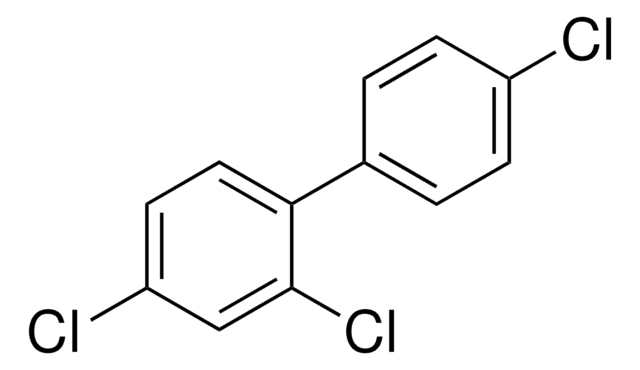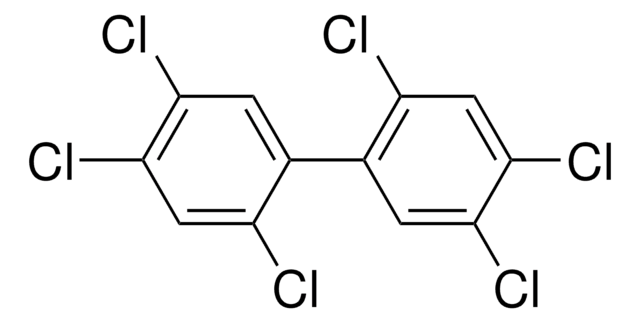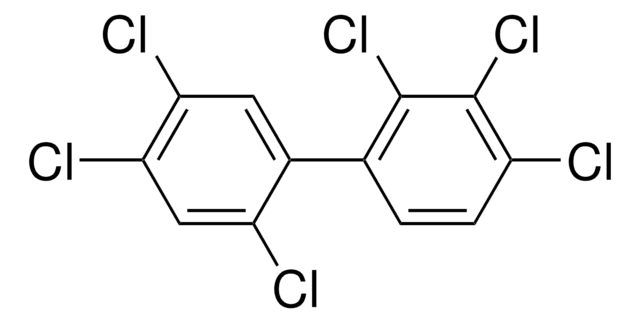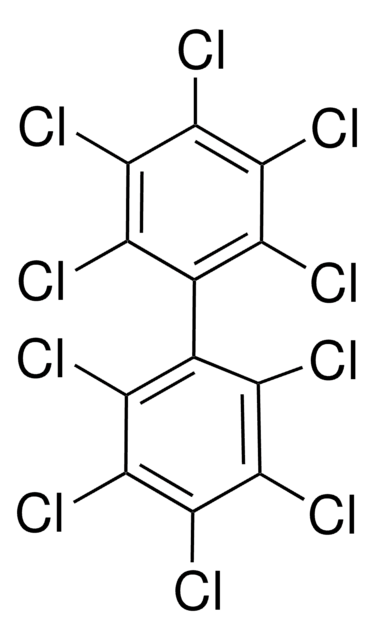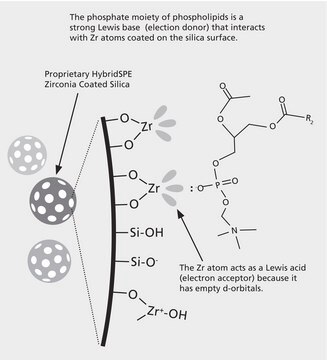BCR291
2,4,4′-Trichlorobiphenyl
BCR®, certified reference material
Sign Into View Organizational & Contract Pricing
All Photos(1)
About This Item
Empirical Formula (Hill Notation):
C12H7Cl3
CAS Number:
Molecular Weight:
257.54
Beilstein:
1956846
Ballschmiter Number:
28
EC Number:
MDL number:
UNSPSC Code:
41116107
PubChem Substance ID:
NACRES:
NA.24
Recommended Products
grade
certified reference material
Agency
BCR®
manufacturer/tradename
JRC
format
neat
storage temp.
2-8°C
SMILES string
Clc1ccc(cc1)-c2ccc(Cl)cc2Cl
InChI
1S/C12H7Cl3/c13-9-3-1-8(2-4-9)11-6-5-10(14)7-12(11)15/h1-7H
InChI key
BZTYNSQSZHARAZ-UHFFFAOYSA-N
Looking for similar products? Visit Product Comparison Guide
Related Categories
Analysis Note
For more information please see:
BCR291
BCR291
Legal Information
BCR is a registered trademark of European Commission
Signal Word
Warning
Hazard Statements
Precautionary Statements
Hazard Classifications
Aquatic Acute 1 - Aquatic Chronic 1 - STOT RE 2
WGK
WGK 3
Flash Point(F)
Not applicable
Flash Point(C)
Not applicable
Choose from one of the most recent versions:
Certificates of Analysis (COA)
Lot/Batch Number
Sorry, we don't have COAs for this product available online at this time.
If you need assistance, please contact Customer Support.
Already Own This Product?
Find documentation for the products that you have recently purchased in the Document Library.
Chen Tu et al.
Journal of hazardous materials, 186(2-3), 1438-1444 (2011-01-05)
Resting cell assay and soil microcosms were set up to investigate the biodegradation capability and metabolic intermediate of polychlorinated biphenyls (PCBs) by a rhizobial strain Sinorhizobium meliloti. Biodegradation was observed immediately after 2,4,4'-TCB was supplied as a sole source of
Leticia Gómez-Gil et al.
Journal of bacteriology, 189(15), 5705-5715 (2007-05-29)
Biphenyl dioxygenase (BPDO) catalyzes the aerobic transformation of biphenyl and various polychlorinated biphenyls (PCBs). In three different assays, BPDO(B356) from Pandoraea pnomenusa B-356 was a more potent PCB-degrading enzyme than BPDO(LB400) from Burkholderia xenovorans LB400 (75% amino acid sequence identity)
A J Lambo et al.
Journal of applied microbiology, 102(5), 1318-1329 (2007-04-24)
To determine the extent and pattern of degradation of polychlorinated biphenyls (PCBs) in Aroclor 1232 at 5 degrees C by a psychrotolerant bacterium, and to confirm the formation of intermediates of PCB metabolism at low temperature using 2,4,4'-trichlorobiphenyl (2,4,4'-TCB). 10
Shui-Ping Wu et al.
Huan jing ke xue= Huanjing kexue, 32(11), 3277-3283 (2012-02-03)
The levels and congener patterns of 28 PCBs compounds were investigated in soil and dust fallout collected in a capacitor storage site and an industrial brownfield, respectively in Sichuan Ziyang Locomotive Factory. The highest concentration of the total PCBs(sigma PCBs
Yu Wang et al.
Environmental science and pollution research international, 19(2), 448-457 (2011-08-09)
Dechlorination of polychlorinated biphenyls (PCBs) by nanoscale zerovalent iron (NZVI) is often strongly hindered by increased pH because large amounts of H(+) ions were consumed during the surface reaction. The main objective of this work was to evaluate the effect
Our team of scientists has experience in all areas of research including Life Science, Material Science, Chemical Synthesis, Chromatography, Analytical and many others.
Contact Technical Service